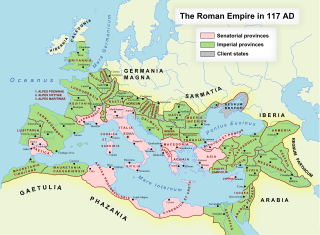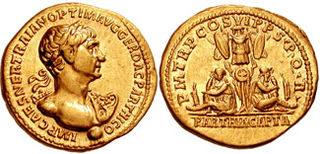
Trajan was Roman emperor from 98 to 117. Officially declared by the senate optimus princeps, Trajan is remembered as a successful soldier-emperor who presided over one of the greatest military expansions in Roman history and led the empire to attain the greatest territorial extent in history by the time of his death. He is also known for his philanthropic rule, overseeing extensive public building programs and implementing social welfare policies, which earned him his enduring reputation as the second of the Five Good Emperors who presided over an era of peace within the Empire and prosperity in the Mediterranean world.
The 40s decade ran from January 1, AD 40, to December 31, AD 49.
The 100s decade ran from January 1, 100, to December 31, 109.
The 110s decade ran from January 1, 110, to December 31, 119.

The 2nd century BC started the first day of 200 BC and ended the last day of 101 BC. It is considered part of the Classical era, although depending on the region being studied, other terms may be more suitable. It is also considered to be the end of the Axial Age. In the context of the Eastern Mediterranean, it is the mid-point of the Hellenistic period.
The 130s decade ran from January 1, 130, to December 31, 139.
The 170s decade ran from January 1, 170, to December 31, 179.
Year 116 (CXVI) was a leap year starting on Tuesday of the Julian calendar. At the time, it was known as the Year of the Consulship of Lamia and Vetus. The denomination 116 for this year has been used since the early medieval period, when the Anno Domini calendar era became the prevalent method in Europe for naming years.

Year 117 (CXVII) was a common year starting on Thursday of the Julian calendar. At the time, it was known as the Year of the Consulship of Niger and Apronianus. The denomination 117 for this year has been used since the early medieval period, when the Anno Domini calendar era became the prevalent method in Europe for naming years.
The 330s decade ran from January 1, 330, to December 31, 339.
This article concerns the period 159 BC – 150 BC.

Legio III Cyrenaica, was a legion of the Imperial Roman army. The legion had its origins among the forces of Mark Antony during the civil wars of late first century BC. In the Imperial period it was stationed in Egypt, where it played a key role in campaigns against the Nubians and Jews. In the first century AD, it was usually located in Arabia Petraea. There are still records of the legion in Syria at the beginning of the 5th century. The legion symbol is unknown.

The Kitos War was one of the major Jewish–Roman wars (66–136). The rebellions erupted in 115, when most of the Roman armies were fighting Trajan's Parthian War on the eastern border of the Roman Empire. Major uprisings by Jews in Cyrenaica, Cyprus and Egypt spiralled out of control, resulting in a widespread slaughter of the remaining Roman garrisons and Roman citizens by Jewish rebels.
Quintus Marcius Turbo was prefect of the Praetorian Guard and a close friend and military advisor to both emperor Trajan and Hadrian during the early 2nd century.
Lukuas was one of the leaders of Jewish rebels during the Kitos War, also known as the Second Jewish War, in the 2nd century AD. The narrative of the revolt under Lukuas is told by Eusebius of Caesarea, Michael Syrus, Bar Hebraeus and Cassius Dio, with the latter giving him a quite different Greek name of "Andreas". Very little is known regarding his life and political career beyond these passing references. Eusebius of Caesarea ascribes him the title of "King", leading many later scholars to believe he attempted to assume the title of "King of the Jews" during his political career, but actually there is scarcely any real evidence of a religious connection to that ascribed title.
The Roman–Parthian Wars were a series of conflicts between the Parthian Empire and the Roman Republic and Roman Empire. It was the first series of conflicts in what would be 682 years of Roman–Persian Wars.

Trajan's Parthian campaign was engaged by Roman Emperor Trajan in 115 against the Parthian Empire in Mesopotamia. The war was initially successful for the Romans, but a series of setbacks, including wide-scale rebellions in the Eastern Mediterranean and North Africa and Trajan's death in 117, ended in a Roman withdrawal.





